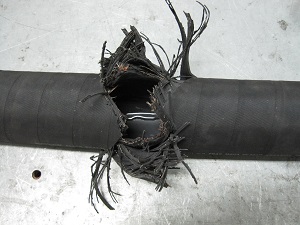PRESSURE VESSELS
Pressure vessels have two stresses to check - hoop stress and axial stress. Hoop stress is always twice the axial stress.
Lecture Notes: ![]() Pressure-Vessels.pdf
Pressure-Vessels.pdf
![]() Pressure-Vessels.one
Pressure-Vessels.one
| Image | Video Lesson Description and Link | Duration | Date | Download |
| 6:40 min | 20140813 |
Pressure Vessels
STRESS IN A THIN-WALLED
PRESSURE VESSEL
Hoop Stress sH
(MPa)
sH
= PD/2t
Axial Stress sA
(MPa)
sA
= PD/4t
Where:
P = pressure of the fluid (MPa)
D = diameter of the tank (mm). This
is the inside diameter, but with a "thin-wall" it doesn't matter.
t = thickness of tank wall. (mm) Should
be pretty small compared to D.
 |
Here is a typical pressure vessel made of welded steel. The cylindrical portion is made from flat plate rolled into a circle and then welded (Joints A). These joints must withstand the hoop stress. The vertical joints (Joints B) handle only axial stresses, which is half the hoop stress. The ends are pressed to form a partially spherical shape (a complete hemisphere would have 1/2 the stress of the cylinder - so they make an ellipsoid, which also happens to be much easier to press into shape). |
Pipes
Pipes, hoses and tubes under pressure are another type of pressure vessel. Being cylinders, they will fail in hoop stress. Reinforced flexible hoses have cross-ply fibres that absorb both hoop and axial forces.

Hydraulic hose assembly undergoing a pressure test to failure. Hoses typically have a safety factor of 4. This 2 inch (50mm) hose is rated at 420 bar (42 MPa) and reached 1650 bar (165MPa) before it failed...like this:

Bird's nest failure of hydraulic hose. This is typical for an overpressure (burst) failure, the ruptured fibres release the pressurized oil with considerable energy (explosively). At the same pressures, compressed air would be even more dangerous than pressurized oil because air expands, creating an even more explosive effect. In hydraulics, the level of danger is in proportion to how much fluid is constrained elastically - in flexible hoses and accumulators. A large diameter, long hose will explode more violently than a small, short one, which is one reason to use solid steel tube wherever possible.
Example:
A carbonated drink bottle is pressurized and tested to failure.(Video below)
This PET (Polyethylene terephthalate) bottle was pumped up to 150 PSI.
Note that it still needed to be scratched by concrete in order to fail, so 150 PSI is a bit conservative.
How much stress in the PET?
(Here, we work in mm and MPa)
Diameter = 87mm (unpressurized), approx 100mm (pressurized)
Thickness = 0.3mm
Pressure = 150 PSI = 1034214 Pa
Hoop Stress;
sH = PD/2t = 1.034214*100/(2*0.3) = 172.37 MPa
Wow! That is a high stress for a piece of plastic.
According to this site, PET has an ultimate tensile strength of 12400 PSI (85.5 MPa), so it is likely that the blow moulding process enhances the properties of the polymer. (By orienting the molecules)
What is the safety factor?
According to HyperTextbook.com, a soda drink at room temperature has a pressure of about 30-55 PSI
This equates to a safety factor of 3 to 5. So the bottle is designed to withstand 3 to 5 times the CO2 pressure. So a shaken bottlethat falls off a shelf should hopefully be safe. This is why PET is used, because few other plastics could handle the stress without being much thicker walled.
More: http://www.aircommandrockets.com/procedures.htm#MOP
This website and accompanying videos give some similar pressure figures, although some are above 200 PSI.
Whiteboard
SUMMARY


Questions:
Assignment: Do all questions 32:1-32:10 (Pressure Vessels)